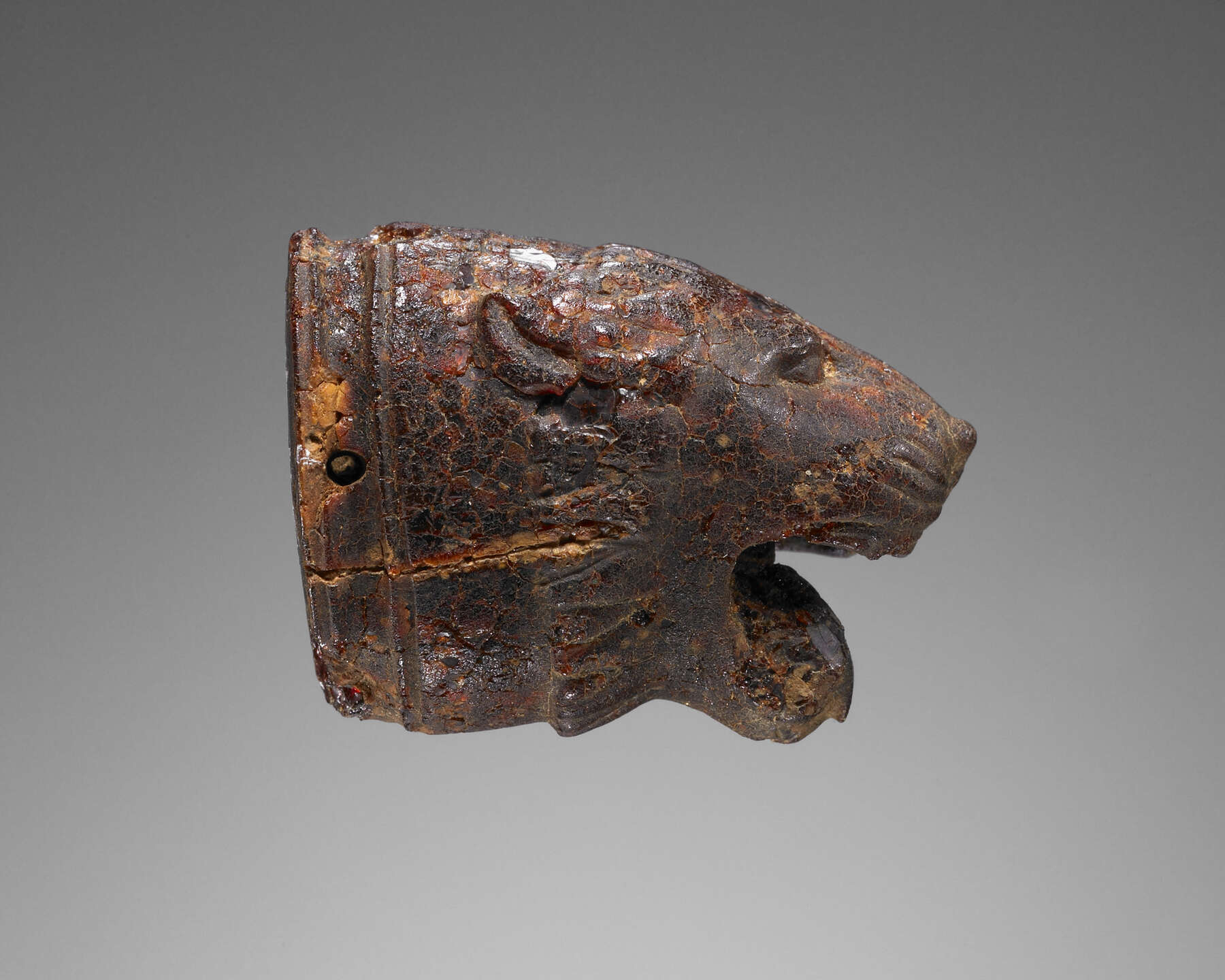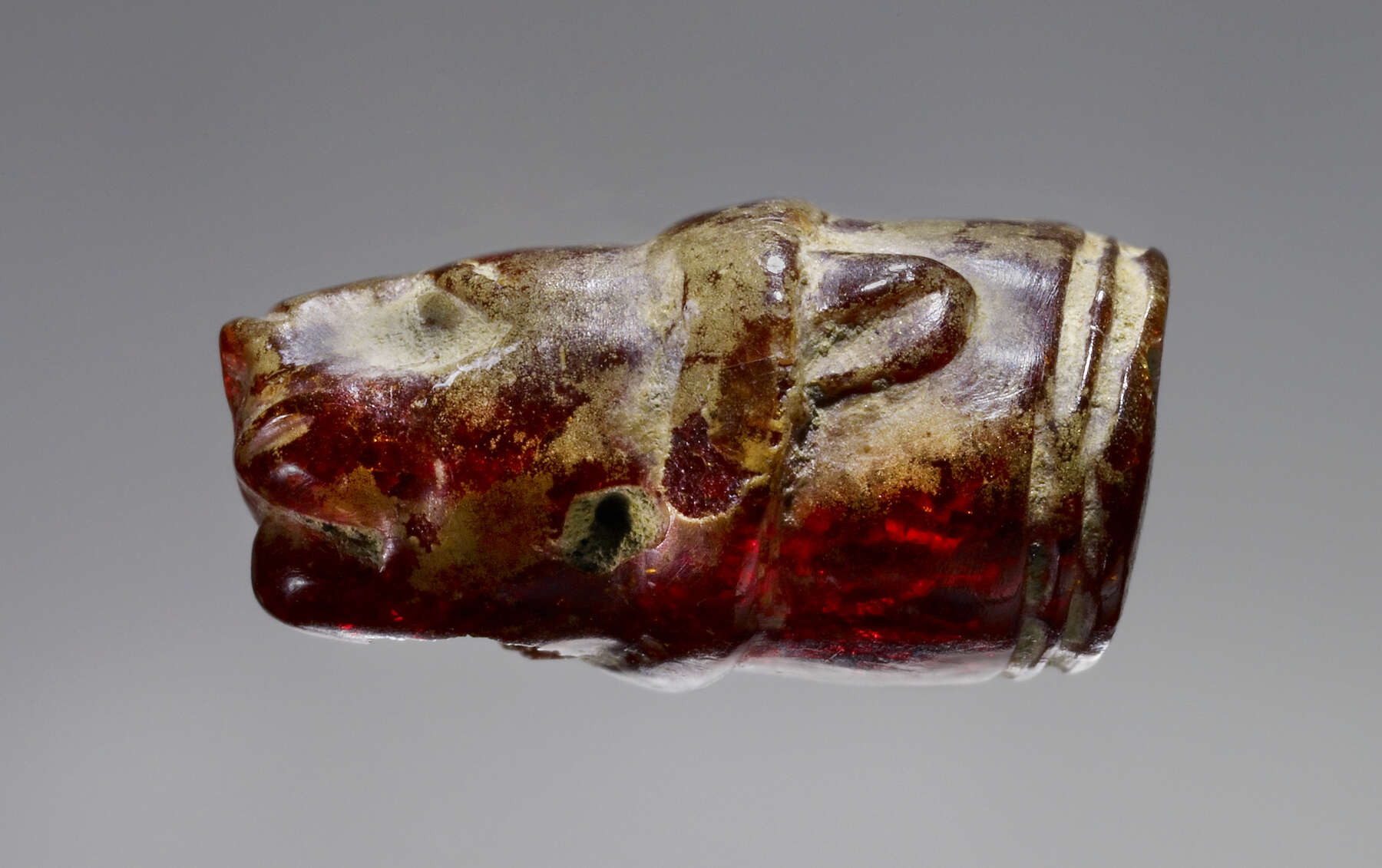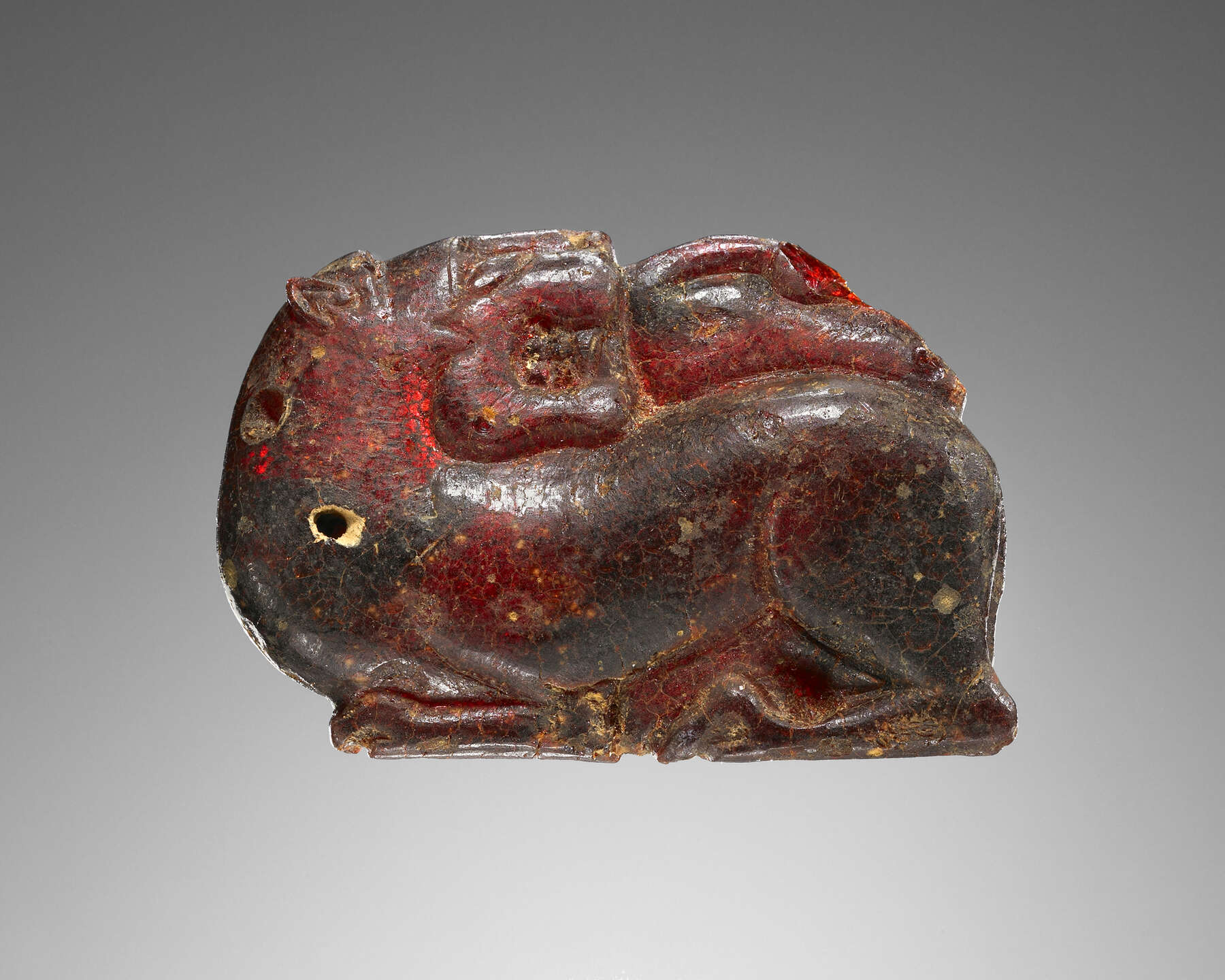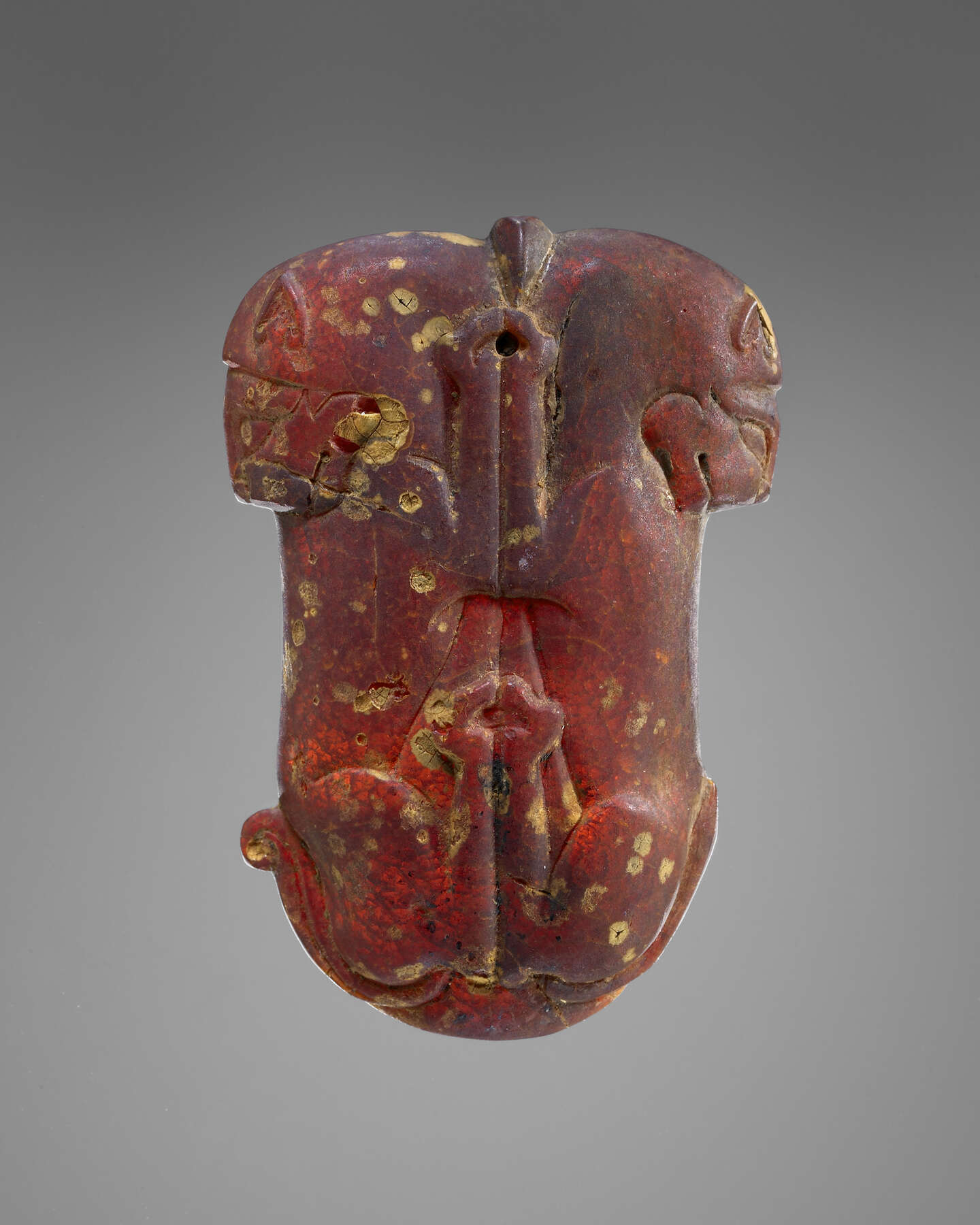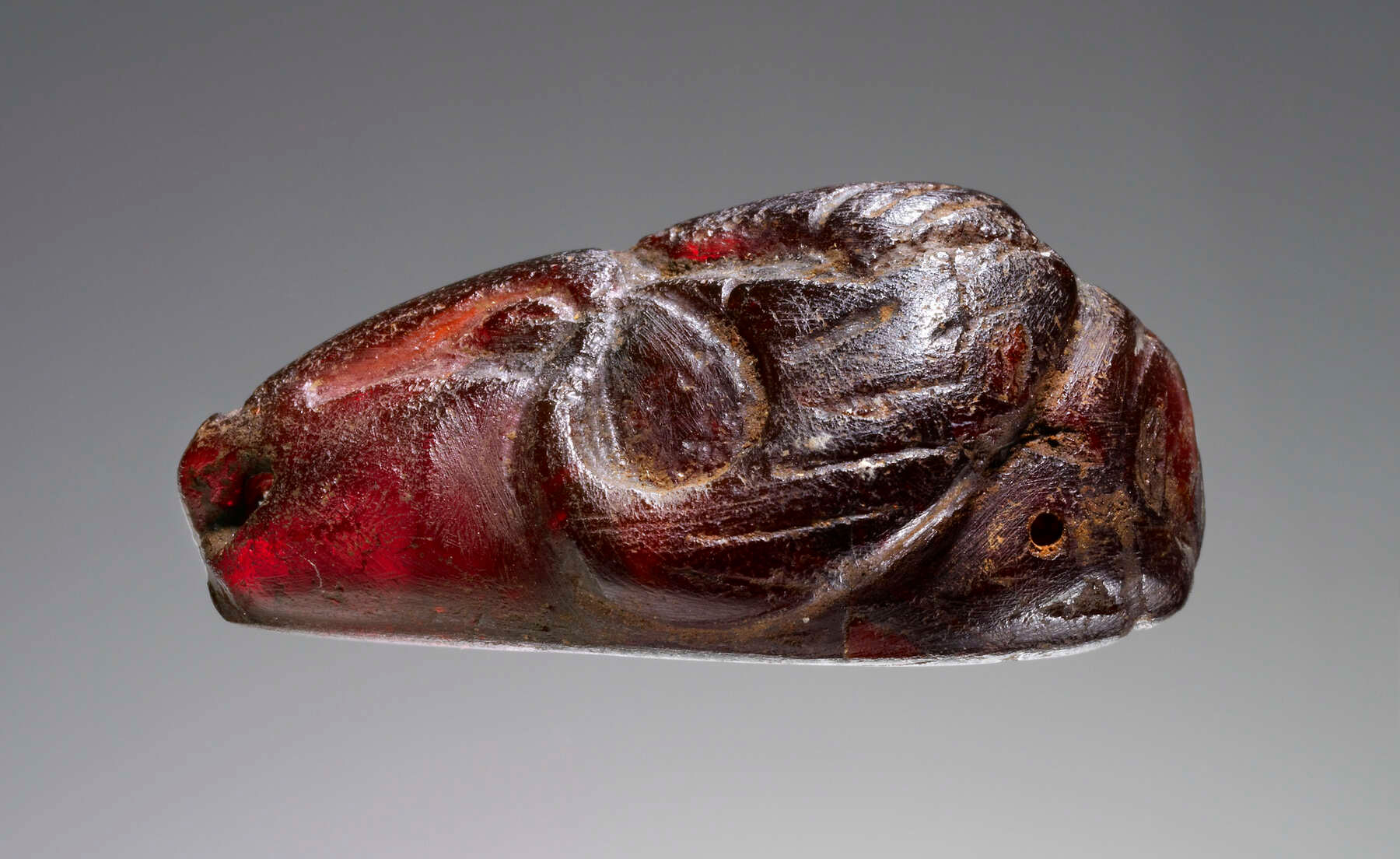After rams’, lions’ are the most numerous of all pre-Roman animal heads in amber. The Getty collection reflects the relative popularity of these two animal subjects: there are four lions’ and fifteen rams’ heads. A feature found on almost all the amber animal heads is the collarlike finial section in imitation of a metal mount, which shows that the amber examples imitate pendants made entirely of gold (or another precious metal) or of another material such as ivory set in a metal mount.
The list of amber lions’ heads now includes the four examples in the Getty Museum, (cat. no. 33), (cat. no. 34), (cat. no. 35), and (cat. no. 36); a pair now serving as the finials of two gold bracelets of Hellenistic date in the Louvre, findspot unknown;1 a pair from an amber-rich find at Novi Pazar, St. Peter’s Church (Etruscan? late sixth century B.C.), and a single lion’s head from a tomb at Atenica of the same date;2 a single(?) lion’s head from Canosa(?) in London (British Museum 78);3 and the dozen or more tiny lions’ heads on three Etruscan necklaces, one in Paris from a controlled excavation and two others on the London and New York art markets said to be from Etruria.4 On each necklace, the lions’ heads are joined by an equal number of rams’ heads and plain beads.
Parallels for the amber heads include complete amber lions, as Donald Strong noted about a lion’s head in the British Museum,5 and lion-foreparts pendants, one excavated with context from the girl’s Tomb 102 at Braida di Vaglio, near Melfi,6 and another from Armento, now in London.7
There is a difference between these Late Archaic lions and the earlier, sixth-century examples in the Getty and elsewhere (i.e., , cat. no. 5; , cat. no. 6; and two in Paris). The later Etruscan and other Italian-made lions of the Late Archaic are characteristically a mélange: the style is a complex blend not borrowed from any one source.8 The earliest amber lions’ heads in the Getty, and a related few amber examples, demonstrate visibly their Oriental antecedents—their Assyrian, Hittite, and East Greek connections. In the case of and , the Assyrian elements are salient through comparison to the beasts of Ashurbanipal. The East Greek elements are brought out by comparison to marble lions such as those from Miletos and Ephesus,9 to an East Greek terracotta vessel in the shape of a lion protome,10 and to various carved gems and tiny ivories. Of the last, salient comparisons are the lions (and lions’ heads) engraved on a number of Ionian Greek gemstones, notably a plasma scarab signed by Aristoteiches11 and a pair of Ionian ivory lions’ heads from Smêla, whose eyes are inset with amber.12 The longevity of the Ionian lion types in adornment might be exemplified by the finials of a pair of late-fourth-century B.C. silver bracelets with gold lions’ heads from Pantikopaion, now in St. Petersburg.13
Comparable Etruscan contemporary lions’ heads in other media (which have known provenances) come from southern Etruria, mainly Vulci, but also from Cerveteri, Orvieto, and Tarquinia. These include the tiny gold finials of a blue glass bracelet from Vulci,14 gold pendants in Berlin, Paris, and Edinburgh,15 and the larger lions’ heads of hammered bronze, especially an example from Orvieto, now in Boston.16 The above-noted examples have in common a similar anatomical form, a similar modeling of the eye area, tipped-up noses, deeply carved mouths, and comparable ferocious expressions. The Orvieto bronze is remarkably like in the length, depth, and form of the head, and in the schema of the dagged mane ruff.
The only extant Etruscan painting of lions’ heads is found on one of the many necklaces and garlands hanging from the branches of the sacred grove painted in the first chamber of the Tarquinian Tomb of Hunting and Fishing (see introduction, figure 40). The painted lions’ heads correspond closely with extant contemporary gold, ivory, and amber lions’ heads. This depiction suggests an amuletic or religious function for the objects.17 Demonic forces are attracted and repelled; propitious forces are invited.
As noted earlier, a lion of amber combined a potent subject with a potent material, one where the magical aspects of amber and subject, the color of the material and the representation, were matched up. Lion and amber were from earliest times associated with the sun, as was much-prized carnelian, which is very like amber in appearance. Carnelian was traditionally employed in Egypt for pendants of lions’ heads and lions’ foreparts.18 Most early Greek and Etruscan gemstones of lion subjects are also carnelian. A subject—such as the lion—that enhanced the inherent danger-averting, protective, and regenerative aspects of these solar materials might have been a straightforward choice.
Amber lions’ heads likely served as permanent amulets—that is, as both ornament and magical object. For almost two thousand years before the series of amber and gold head-pendants were produced, lion, lion’s-head, and lion-foreparts amulets similar to them in schema and materials had been popular in Egypt. As a symbol of the sun-god, Ra, the lion was, by extension, a symbol of the pharaoh. Worn in life, a lion-subject amulet could symbolize fierceness and bravery, endowing its owner with the same qualities; thus, in life or in death it could function as a protective, danger-averting amulet. The lion-foreparts amulet, unique to the Egyptian late Old Kingdom and First Intermediate periods, was set at the neck to protect the deceased from a second death and endowed the owner with the ability to come forth from the realm of the dead and “become an excellent spirit.”19 The Egyptian beliefs in the regenerative capabilities of the lion (characteristic of all desert dwellers) are assumed to underlie the symbolism of the lion’s-head amulets that were current from the late Old Kingdom through the Late Period.20 Both lion-foreparts and lion’s-head types were almost exclusively carved from carnelian.
Because of the Assyrian typological and stylistic aspects of , the important role played by the lion in adornment and architecture during the Neo-Assyrian period should be recalled: as noted earlier, the lion was a generally magically protective type (known as urgulû).21
There are demonstrable connections in Greek myth and the material culture of Greece among Apollo, the sun, and the lion. If the trees on the walls of the first chamber in the Tomb of Hunting and Fishing depict Apollo’s sacred grove, as some scholars have posited, the necklace with (amber?) lion’s-head pendants (and the necklace with ram’s-head pendants hanging on another tree) may take on special import. If, however, the dancers of the Hunting and Fishing tomb are directly connected to Fufluns/Dionysos, the god of wine, as Sybille Haynes proposes, the tomb may illustrate Dionysian religiosity.22 In any case, the dance is apotropaic and purificatory. In either interpretation, the lions’ and rams’ heads were appropriate to the painted events.23
Although the Getty amber lions’ heads are generally similar in format and function to one another (as well as to amber heads in other collections and to protomes in other media), each is idiosyncratic. The Getty lions’ heads demonstrate both a close relationship to existing types and models and the distinctive hand of individual carvers. , , and are pendants, bored laterally in the neck area. is perforated with a large rostrocaudal through-bore and has a beveled edge. This indicates a usage different from those of all other amber lions’ heads. may have served as a finial, such as a finial bead on a necklace, the likely purpose of one of the amber ram pendants in the Getty collection (, cat. no. 52). However, the size of the hole and the delicacy of the carving of the lion’s mouth suggest other functions; possibly it served as the added spout of a small vessel. In addition to the pendants, there are two other amber lions’ heads in the Getty collection, the finials of (cat. no. 38), a plaque with a walking boar as its subject.
Notes
- For the lions’ heads in the Louvre, see and the discussions under and . ↩
- For the material from Novi Pazar, St. Peter’s Church, and Atenica, see . ↩
- , p. 81, no. 78, pl. XXX. ↩
- The amber necklace included in the 1992 Paris exhibition Les Etrusques et l’Europe was hors catalogue. One of the other necklaces was on the London art market in 1982 (it included nine small lions’ heads and two rams’ heads of very similar size [height: 12 mm; length: 15 mm; width: 13 mm], and one large lion’s head [height: 21 mm; length: 30 mm; width: 24 mm]); the second, with even smaller pendants, is in a New York private collection. I thank B. Aitken for facilitating my study of the New York necklace. ↩
- , p. 81. ↩
- For the Braida di Vaglio necropolis, see . ↩
- , p. 80, no. 75, pl. XXIX. ↩
- , p. 94. ↩
- See cat. no. 31, n. 3 and n. 4. ↩
- This early Corinthian example and other, East Greek, examples are generally accepted by scholars as Rhodian. As W. A. Biers, “A Lion in Kansas City,” in , p. 35, outlines, the lion vase has antecedents in metal drinking vessels of the Neo-Assyrian and Achaemenid periods. The secondary(?) use of plastic vases in Etruscan graves may be connected with an amuletic aspect of the containers and the goods. For the magical and medicinal aspects of oils, scents, and “perfumes,” see Brunner-Traut 1970 (in “The Archaic and Afterward” in the introduction, n. 214); and L. Manniche, Sacred Luxuries: Fragrance, Aromatherapy, and Cosmetics in Ancient Egypt (Ithaca, NY, 1999). See also Lost Scents: Investigations of Corinthian “Plastic” Vases by Gas Chromatography-Mass Spectrometry, MASCA Research Papers in Science and Archaeology 11, ed. W. A. Biers, K. O. Gerhardt, and R. Braniff (Philadelphia, 1994). ↩
- , p. 134, placed the plasma scarab in East Greece: “The inscription points to the Ionic islands of the Cyclades rather than Ionia. Beazley adduced telling parallels with Cypriot coins of the early fifth century from Amathus and Golgoi. Cf. also the terracottas of East Greece.” , p. 421, includes additional bibliography for the plasma. ↩
- , p. 259, fig. 301; G. Minns, Scythians and Greeks (repr., London, 1971), pp. 78, 193 (fig. 85), 266. ↩
- Hermitage P. 1854.289: D. Williams and J. Ogden, Greek Gold: Jewelry of the Classical World, exh. cat. (New York, 1994), pp. 156–57, no. 96. Etruscan burials included numerous lion subjects on items of adornment or as singletons. The single gold lion’s heads in Paris (Bibliothèque nationale, Cabinet des Médailles, Luynes 502: , p. 105) and Edinburgh (Scottish National Museum of Antiquities FF 34: ibid., p. 106) were likely single finds. The girl’s grave Tomb 102 at Braida di Vaglio contained 290 worked ambers, 83 of them figured, but only one lion subject, a pendant in the form of a lion’s foreparts. A pair of gold lion’s-head pendants (provenance unknown; circa 500 B.C.) in Berlin (Antikenmuseum GI 416/417: , p. 294, no. 157) and a fragmentary fifth-century gold necklace from Vulci in the Vatican (Museo Gregoriano Etrusco 13542: ibid., no. 156), with three lions’ heads and four clasps that once held amuletic objects such as teeth, document the burial of multiple lions’ heads. ↩
- Rome, Museo Nazionale Etrusco di Villa Giulia 59791 (from Vulci): , pp. 173, 297, no. 174 (with significant comparisons). ↩
- For the pendants in Berlin, Paris, and Edinburgh, see n. 13, above. ↩
- Boston, Museum of Fine Arts 55.497. See also the hammered bronze head once on the Rome art market (provenance unknown): , p. 99, pl. XL b. ↩
- Ibid., p. 106, was the first to draw the connection between existing jewelry and the painted images. On the tomb, see , pp. 20ff., especially the illustrations on p. 96 (the nineteenth-century watercolors of the first chamber by G. Mariani) and the detail of one bush on p. 97; P. Romanelli, “Le pitture della Tomba della Caccia e della Pesca,” Monuments et Mémoires, Fondation E. Piot 1, no. 2 (Rome, 1938); R. Holloway, “Conventions of Etruscan Painting in the Tomb of Hunting and Fishing at Tarquinia,” 69 (1965): 341–47, where he is the first to propose the apotropaic aspects of the subjects, including the objects hanging from the branches in the grove, and his more recent “The Tomb of the Diver,” 110 (2006): 374–75; L. Cerchai, “Sulle Tomba ‘del Tuffatore’ e ‘delle Caccia e Pesca’: Proposta di Lettura Iconologia,” Dialoghi di Archeologia 5 (1987): 113–34; A. Rouveret, “La tombe tarquinienne de la Chasse et de la Pêche: Quelques remarques sur la peinture de paysage à l’époque archaïque,” (1992): 170–71; ; and , pp. 228–30. All these sources provide significant comments on the grove, which is discussed later in the section introducing rams’ heads. ↩
- Some archaeological ambers have been identified as carnelian and vice versa: see, for example, Todd 1985 (in “Where is Amber Found,” n. 37), generally in reference to the Bronze Age material; and , p. 426, n. 1111, concerning a carnelian scaraboid from Satricum (Rome, Museo Nazionale Etrusco di Villa Guilia 10809), which was published as being of amber. The color and transparency ranges of carnelian and red jasper are comparable to those of amber. On carnelian in the ancient world, see . ↩
- As , p. 79nn., notes, this amulet type is specifically required by Coffin Text no. 83. The Egyptian lion-foreparts amulet is very close in form to the two extant ambers of the type, British Museum 75 and a sphinx pendant from Tomb 102 at Braida di Vaglio. For the latter, see (with earlier bibl.); and , pp. 224–25. ↩
- , p. 65. ↩
- , p. 119. ↩
- The Dionysian interpretation “is confirmed by the representation of satyrs with drinking horns reclining in the gable of the entrance wall” (, p. 229). See I. Krausfopf, “The Grave and Beyond,” in The Religion of the Etruscans (Austin, TX, 2006), pp. 77, 82–83, for a critical summary of arguments for Fufluns/Dionysos in the Etruscan tomb and interpretations of the Tomb of Hunting and Fishing, with bibl., including M. Torelli, Il rango, il rito, e l’immagine: Alle origini della rappresentazione storica romana (Milan, 1997); M. Cristofani, “Mystai kai bakchoi: Riti di passagio nei krateri volterrani,” Prospettiva 80 (1995): 2–14; C. Weber-Lehman, “Spätarchaïsche Gelagebilder in Tarquinia,” 92 (1985): 19–44; and E. Simon, “Die Tomba dei Tori und der etruschische Apollonkult,” 88 (1973): 27–42. Simon believes the large plants in the tomb represent laurel trees. ↩
- For further discussion of the ram’s-head necklace and the painted grove, see “Rams’ Heads” introduction. ↩
Bibliography
- Andrews 1994
- Andrews, C. Amulets of Ancient Egypt. Austin, TX, 1994.
- Black and Green 1992
- Black, J., and A. Green. Gods, Demons and Symbols of Ancient Mesopotamia: An Illustrated Dictionary. Austin, TX, 1992.
- Boardman 1968
- Boardman, J. Archaic Greek Gems. London, 1968.
- Boardman 2001
- Boardman, J. Greek Gems and Finger Rings: Early Bronze Age to Late Classical. New and enlarged ed. New York, 2001.
- Boardman 1980
- Boardman, J. The Greeks Overseas: Their Early Colonies and Trade. New and enlarged ed. London, 1980.
- Bottini and Setari 2003
- Bottini, A., and E. Setari. La necropoli italica di Braida di Vaglio in Basilicata: Materiali dallo scavo del 1994. With appendix by M. Torelli. 60, serie miscellanea 7. Rome, 2003.
- Brown 1960
- Brown, W. L. The Etruscan Lion. Oxford, 1960.
- Caubet 1999
- Caubet, A., ed. Cornaline et pierres précieuses: La Méditerranée, de l’Antiquité à l’Islam; Actes du colloque organisé au Musée du Louvre les 24–25 novembre 1995. Paris, 1999.
- Clark and Gaunt 2002
- Clark, J., and J. Gaunt, eds. Essays in Honor of Dietrich von Bothmer. With B. Gilman. Amsterdam, 2002.
- Cristofani and Martelli 1983
- Cristofani, M., and M. Martelli, eds. L’oro degli Etruschi. Novara, 1983.
- Haynes 2000
- Haynes, S. Etruscan Civilization: A Cultural History. Los Angeles, 2000.
- Metzger 1991
- Metzger, C. “Noeud d’Héraclès et torsades: Trois bijoux hellénistiques.” Revue du Louvre 41 (1991): 18–23.
- Palavestra and Krstić 2006
- Palavestra, A., and V. Krstić. The Magic of Amber. Belgrade, 2006.
- Simon 1998
- Simon, E. “Apollo in Etruria.” Annali della Fondazione per il Museo “Claudio Faina” 5 (1998): 119–43.
- Steingräber 2006
- Steingräber, S. Abundance of Life: Etruscan Wall Painting from the Geometric Period to the Hellenistic Period. Translated by R. Stockman. Los Angeles, 2006.
- Strong 1966
- Strong, D. E. Catalogue of the Carved Amber in the Department of the Greek and Roman Antiquities. London, 1966.
- Treasures 1998
- Treasures from the South of Italy: Greeks and Indigenous People in Basilicata. Exh. cat. Milan, 1998.
- Waarsenburg 1995
- Waarsenburg, D. J. The Northwest Necropolis of Satricum: An Iron Age Cemetery in Latium Vetus. Amsterdam, 1995.
